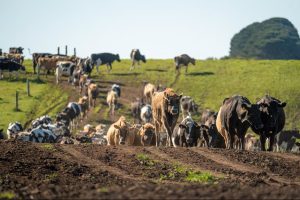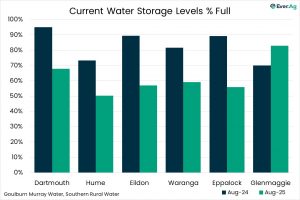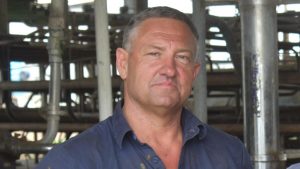
Almost everything on the shelves at Wadeye’s Murrinhpatha Nimmipa Store — the only shop within a 400-kilometre radius — is more expensive than a couple of months ago.
Manager Jake Clarke said he hadn’t raised the margin on food items in more than a decade, but in the wake of a straining global supply chain, adverse weather and rising fuel and energy prices, he had no choice.
“We are getting to the point where we are just covering our costs,” he said.
“It’s not because I want to, it’s because I have to.”
Corned beef was selling for $15 and fruit and vegetables, Mr Clarke said, were sold at a loss to ensure healthy food remained affordable.
Prices for produce had also spiked at Ramingining, a mainland community of about 900 people almost 600 kilometres east of Darwin.
A sign at the Arnhem Land Progress Aboriginal Corporation store stated cost increases in fuel and freight have had a significant impact.
“We have had to make the difficult decision to pass on some of these costs.”
In Ramingining, 1 kilogram of Nescafe instant coffee had skyrocketed to more than $74, small containers of cream were sold for almost $8, and powdered milk cost $10.25.
Costs passed on to customers
A corporation spokeswoman said the organisation was paying $250,000 a quarter in extra freight charges to get goods to its six Arnhem Land stores compared to the same time last year.
She said the corporation had tried to soften the impact of inflation.
“We are seeing cost increases across all areas of the business and [this month’s] Fairwork Australia decision, whilst understandable and fair, will add over $1,000,000 to our employment costs across our activities and businesses,” she said.
“At the moment we are seeing customers having to take products out of their shopping baskets to make their dollars stretch.”
The latest March inflation data from the Australian Bureau of Statistics showed food inflation was up 4.3 per cent compared to a year ago, with the biggest jump being in the price of fresh vegetables and meat — at 6.7 per cent and 6.2 per cent respectively.
Urapunga community store worker Mandy Jeffs said price labels had been renewed to reflect rising costs when she returned from a recent two-week break.
“Meat just jumped by a few dollars … we don’t sell a lot of that because it has become too expensive.”
High cost could worsen epidemic
Australian Medical Association Northern Territory president Robert Parker said inflationary pressures, particularly on fuel and primary produce, were especially stark in the wake of stagnant wage growth.
“People are having to spend more and more of their limited income to maintain their fresh food intake,” he said.
Dr Parker said prohibitory prices could lead to higher salt and sugar intakes, inflaming an already growing diabetes epidemic in remote NT communities.
“Certainly, the price of food can potentially hurt our health impacts,” he said.
He said subsiding food was a potential solution.
Outback Stores chief executive Michael Borg said none of the remote community shops his company ran across the Northern Territory and Western Australia had been immune to the challenges of inflationary pressures.
“Not all of the increased supply costs have been reflected in the price to customers yet,” Mr Borg said.
He said there had been some moderate price increases across the range but the business hadn’t been as badly impacted as east coast retailers because fresh produce was mostly sourced from southern suppliers.
“In fact, for an example, lettuce is currently retailing in most of our stores for just $6.50, making it actually either comparable or cheaper than many metropolitan retailers at the moment,” Mr Borg said.
Charities feel price pressure
Foodbank South Australia and Central Australia chief executive Greg Pattison said Alice Springs households were turning to the hunger relief charity as the cost of living crisis deepened.
“We’re starting to see people come in who aren’t necessarily people you would think would require welfare assistance,” he said.
“They are people who have jobs who are just struggling to make ends meet, and for whom the cost of living has meant for a particular time of that month they can’t feed their families.”
He said running costs had increased about $50,000 per month.
He said it was a “real perfect storm”.
“We buy all the food based on our fundraising, we have a limited amount of money so if the costs go up it just means we have less food or it means we have to pass that price on to the people that come in,” he said.
“And they are struggling to make ends meet as it is.”
Government offers support
Recommendations from a 2020 inquiry into food prices and food security in remote Indigenous communities included a live price monitoring tool and a focus on local distribution and food production.
The federal government supported 10 of the 16 recommendations, and more than two years later, Northern Territory Senator Malarndirri McCarthy said the government was still committed to that work.
She said the government was focused on increasing wages and tackling the spiralling cost of living and was committed to replacing the Community Development Program.
Senator McCarthy also said the new scheme would provide a “proper jobs program that actually pays decent wages [and] can certainly provide some relief for cost of living pressures in the bush”.
























